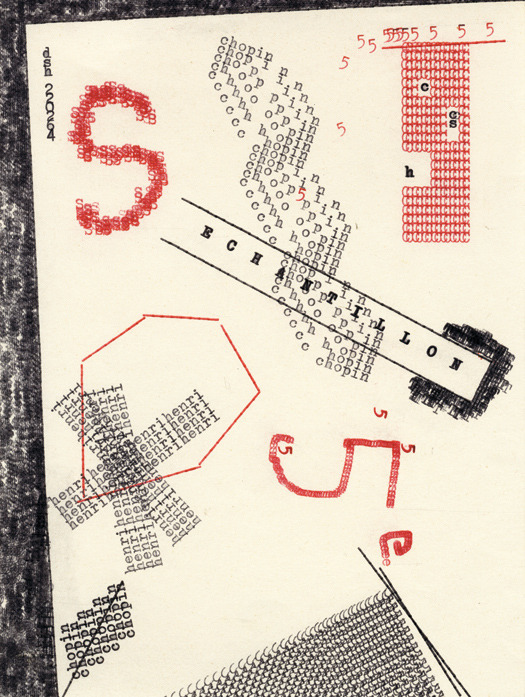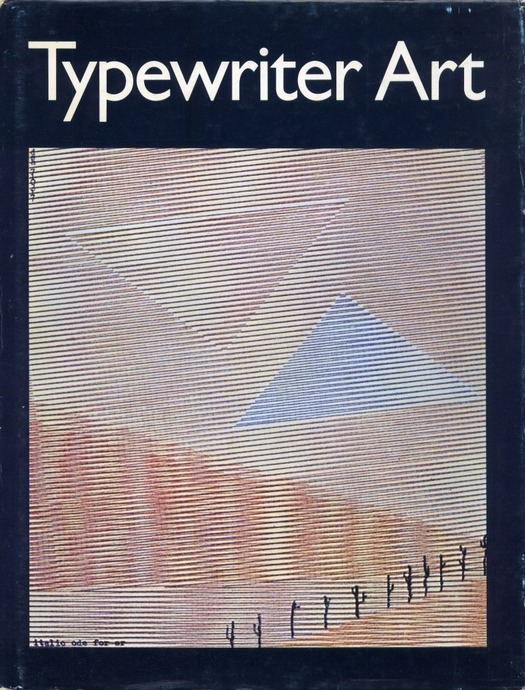Concrete Poetry from the Sackner Collection at PAMM
The first time we entered the Sackner Archive of Concrete and Visual Poetry at the Pérez Art Museum Miami it was like finding our curatorial spirit animal. It was perfect. The room felt as if it was embroidered with words, fonts, shapes made out of barely legible symbols the contents of which were . . . could it be? Words! There was such intimacy in the space, such familiarity of these grounded symbols and yet a complete and open dialogue about what they truly could mean.
Marvin and Ruth Sackner began gathering works of “concrete poetry," poems whose words and typography are arranged to convey meaning graphically, in the mid nineteen seventies. Despite this attraction towards the style, they wouldn't know the genre was called “concrete poetry” until 1979. It was while first encountering Emmett Williams’s Anthology of Concrete Poetry in a book store, that Marvin Sackner, a neurologist by trade, had what he called “a Eureka moment" and turned to his wife Ruth to exclaim, "What we’ve been collecting has a name!".
Their collection had already included rare manuscripts and published works by international luminaries such as Augustor and Heraldo de Campos, Oyvind Fahlström and Eugen Gomringer. The collection subsequently grew to encompass a broad array of historic and contemporary works that synthesize word and image. Rooted in the early to mid-20th-century European avant-garde, the collection provides a unique lens through which to examine the foundational movements of modernism, including Italian Futurism, Russian Constructivism, Bauhaus, De Stijl, Dada and Lettrisme, among others. The Sackners’ contemporary holdings are also expansive, with special strengths in artists' books and "assemblings" (limited-edition groupings of materials by numerous contributors), as well as various sub-genres such as typewriter art, performance poetry and micrography (abstract or representational designs comprised of minuscule lettering). Their exhibition at the Pérez begins with a rare, 1897 publication of "Un Coup de des" (A Throw of the Dice), by Stéphane Mallarmé, which is considered one of the first true examples of concrete poetry, and it includes hundreds of objects spanning more than a century of creative expression.
":Un Coup de Des", (A Throw of the Dice), by Stéphane Mallarmé
Today a moving feature written by ROBIN POGREBIN for the New York Times was released on our beloved client's collection:
For decades, Ruth and Marvin Sackner of Miami collected language-based artworks — typewriter art, artist books, micrography, sound and performance poetry, mail art and experimental calligraphy — amassing what now could be the largest private collection of its kind in the world, the Sackner Archive of Concrete and Visual Poetry.
“Words are everything,” said Mr. Sackner, 84, whose wife died last year.
Now, more than 400 pieces are heading to the Pérez Art Museum Miami, a gift and purchase made possible by the John S. and James L. Knight Foundation and by the archive. The collection — which includes the contents of “A Human Document,” a 2013 show that was part of the museum’s inaugural series — will be highlighted in an exhibition in June 2017.
“This is the kind of thing that can be a game changer for us,” the museum’s director, Franklin Sirmans, said, adding that the museum’s holdings included “nothing this concentrated as a body of work.”
Guillaume Apollinaire’s “Peintures de Léopold Survage” (1917) is among the works that will be at the Pérez Art Museum Miami, collection of Ruth and Marvin Sackner
The Sackner material, grounded in the early 20th-century European avant-garde, brings together examples of modernist movements like Italian Futurism, Dada, Russian Constructivism and Surrealism.
Highlights include Jenny Holzer’s “Olympian Sign” (1986), a continuous LED scroll of the artist’s aphorisms; Carl Andre’s five notebooks, in which he arranged words as sequential modular units; and Guillaume Apollinaire’s “Peintures de Léopold Survage” (1917), featuring 13 picture poems in the form of motifs like horses, clocks and flowers.
Because the collection was built in Miami, the Knight Foundation said it seemed like an acquisition worth supporting. “Three quarters of us who live there come from someplace else,” said Alberto Ibargüen, the president and chief executive of the foundation. “You really need to find ways to bind people — to explain people — to each other as we invent the new Miami that we want it to be.”
Indeed, Mr. Sirmans hopes the Sackner collection will help make the museum more of a destination. “If you are interested in text as it relates to artwork, you kind of have to come see us to really get a sense of this important collection,” he said. “You have to come through here.”







